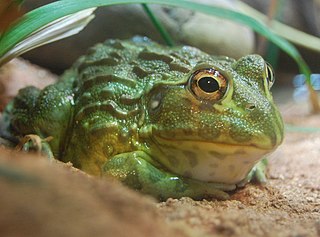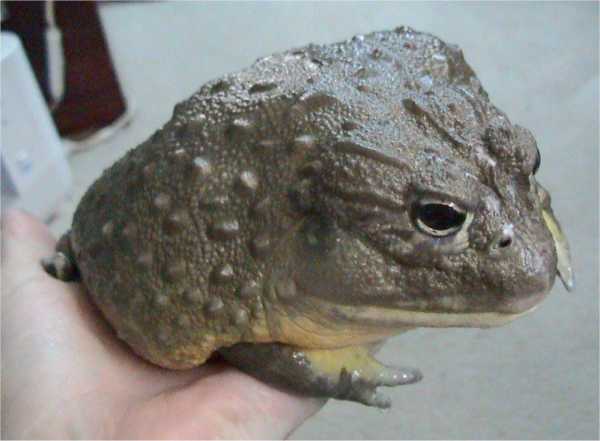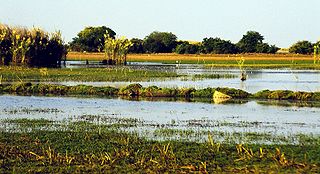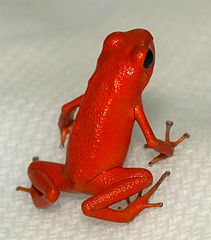Hello, Frank Indiviglio here. Although they are among the heaviest of the world’s frogs, African Bullfrogs, Pyxicephalus adspersus, do well in modestly-sized terrariums. And by “doing well” I mean that they regularly live into their 20’s and 30’s…one even reached 51 years of age! These amazing creatures stretch the limit of what most people think of as “a frog” – armed with tooth-like jaw spikes, males will defend their tadpoles from lions and dig trenches to deliver water. Toughened by a harsh natural environment, African Bullfrogs are resilient beyond belief – one was observed downing 17 hatchling spitting cobras, and during droughts they can remain dormant for 10 to 12 months! Please see articles linked below for more on their astonishing natural behaviors.
The following care guidelines can also be applied to the Dwarf African Bullfrog, P. edulis.
Natural History
African Bullfrogs inhabit seasonally-flooded savannas and swamps in much of Sub-Saharan Africa (please see habitat photo below). They have been recorded in Swaziland, Angola, Botswana, Namibia, South Africa, Zambia and Zimbabwe.
In some populations, cannibalism supplies much food for newly-metamorphosed individuals. I still recall BBC footage of adults taking down huge scorpions and centipedes while being bitten and stung numerous times. I’ve been chased by Kodiak bears and crocodiles, but those scenes made me wince! Invertebrates are their most common prey, but lizards, snakes, rodents and birds are sometimes taken.
The Terrarium
African Bullfrogs are relatively inactive. A 15-20 gallon tank will accommodate an average adult, but a 30-55 gallon tank will be “appreciated”.
Important Note: Terrarium Hygiene
African Bullfrog terrariums must be kept scrupulously clean; ammonia poisoning (ammonia is released when the frog passes waste) is the most common cause of pet death. Animals that have lived in perfect health for decades can be killed overnight if forced to remain in fouled water. Please see this article.
Ease of maintenance is the main consideration when setting up the habitat. Fortunately, African Bullfrogs get along well in simple accommodations. A bare-bottomed aquarium, tilted on one side to create a small water section, is one easily-cleaned option.
Although they will happily dig into the substrate, African Bullfrogs are unusual among frogs in that they are quite content without a completely-secure hiding spot. I favor plastic plants equipped with suction cups as retreats. Simply attach the plant to the glass so that the foliage stretches nearly to ground level. Your frog will push under the plant for shelter. This has worked well for me in zoo exhibits and at home.
Substrate
African Bullfrogs are notorious “substrate-swallowers”, and are prone to intestinal blockages from gravel and other substrates. Bare-bottomed terrariums or washable cage liners are safe options.
Former coworkers of mine began using coconut husk in a zoo exhibit awhile back and report that all is well. The husk seems to pass easily though the digestive tract. Several experienced private frog owners have reported the same. I’m most interested in hearing of others’ experiences…please post below.
Light, Heat and Humidity
African Bullfrogs do not require UVB light, but may benefit from the provision of UVA.
Temperatures should range from 72 F on the cooler side of the terrarium to 85 F; a drop to 68 F at night may be beneficial. Incandescent bulbs http://bitly.com/KbmGmC, night bulbs, or ceramic heaters http://bitly.com/KbmYKf can be used to warm the terrarium.
Although humidity is generally not a concern if they have access to a water bowl, overly-dry substrates may cause these frogs to burrow in and attempt aestivation.
Companions
Juveniles have insatiable appetites and invariably try to swallow even like-sized tank-mates. Same-sized adults may co-exist, but should be fed separately as bites can occur at feeding time.
Feeding
African Bullfrogs, especially while growing, require a great deal of calcium. Whole fishes and, to a lesser extent, pink mice, are ideal calcium sources.
Crickets alone, even if powdered with supplements, are not an adequate diet. Minnows, shiners, earthworms, roaches and crickets can make up the bulk of their diet. Goldfishes may be used on occasion, but should not be a staple.
Pink mice may be offered once each 7-10 days, but are not necessary if fish are consumed regularly. While some success has been had by feeding adult mice to African Bullfrogs, over-use of rodents may lead to liver problems and fur impactions (please see the article linked below). While they certainly take the occasional rodent in the wild, invertebrates and other frogs make up the bulk of the wild diet.
Crayfishes (another good calcium source), butterworms, silkworms and other commercially-available invertebrates should also be included regularly. Feeders should themselves be provided a nutritious diet; please see these articles on cricket and earthworm care).
Canned grasshoppers, snails, and silkworms offer an easy means of increasing dietary variety. Never offer food with your fingers! Use plastic feeding tongs – frogs are “unable to control themselves” when hungry, and often suffer wounds when metal tongs are employed.
I feed cicadas, grasshoppers and other wild-caught invertebrates whenever possible. Please see this article for details and post any questions below.
Food (other than pinkies and fish) should be powdered with Zoo Med ReptiCalcium plus D3 or a similar product. Vitamin/mineral supplements such as ReptiVite should be used 2-3 times weekly.
If you use moss or other substrates, meals are best offered via tongs or in a separate, bare-bottomed enclosure.
Water
Water should be changed daily and treated with a chlorine/chloramine remover.
Handling
African Bullfrogs have powerful jaws, the lower of which bears 3 (2 large, 1 smaller) sharp spikes known as odontoid structures. They are actually bits of bone that extend up from the jaw, and can inflict serious wounds. Fingers moved within reach will elicit a feeding response, and you will be bitten.
Fortunately, it is a simple matter to safely pick up an African Bullfrog by grasping it behind the front legs. Amphibians should be handled only when necessary, and then with wet hands, so that you do not remove their protective mucus. Wash well after handling any animal.
Please check out my posts on Twitter and Facebook. Each day, I highlight breaking research, conservation news and interesting stories concerning just about every type of animal imaginable. I look forward to hearing about your interests and experiences as well, and will use them in articles when possible.
Please also post your questions and comments below…I’ll be sure to respond quickly.
Thanks, until next time,
Frank Indiviglio
Further Reading
African Bullfrog Eats 17 Young Cobras
 That Reptile Blog – Reptile, Amphibian and Exotic Pet Care and Information
That Reptile Blog – Reptile, Amphibian and Exotic Pet Care and Information






I have 3 males and they are awesome! 1 has your average pixie attitude of always on the ready for food and will bite but the other two are more mellow surprisingly. Easy to pick up when needed without having to worry as much about receiving a bite. They eat well and are healthy, perhaps it is their personalities? Also, have you noticed that some pixies prefer borrowing over water dwelling and vice versa? I have 1 that is totally aquatic and the other two are borrowers. Their temps and humidity are fine. I notice this too with how much they move around, two of mine make use of the space in their enclosures and one just borrows down and stays where he feels most comftorable.
Hi Kelsie,
Thanks for the interesting observations…I have noticed definite differences in reactions to handling, and to preference for water etc in this and other frogs. In some cases habitat preference has to do with origin of animals, or their ancestors…species with wide ranges may have adapted to different environments. But I do not believe this is so for Af Bullfrogs. But they seem to do fine either way; large scale breeders tend to keep them in shallow water, to ease cleaning, and that seems to work very well. Enjoy and please keep me posted, best, frank
Hello Frank.
I’m preparing a terrarium for my African Bullfrog and have a question regarding the disposal.
I was thinking on having a “wild” enviroment on it and decided to add some sort of a river, starting in one side, that goes deeper and larger until gets to the other corner. On this last corner, it would be around 20-25cm deep and was thinking on adding 3-4 crayfishes and goldfishes for the frog to hunt.
Is this a good idea or not? Will he be able to hunt underwater? As for crickets and grasshoppers i will just release them inside the terrarium, since i use the coconut husk type as substrate.
Thanks for your time in advance and congrats for the article.
Hello Henrique,
It’s difficult to keep Af Bullfrogs in the type of exhibit you describe. They do not hunt underwater, alhthough they may grab a fish in very shallow water, i.e. if it’s back is exposed, etc. More importantly, it’s very difficult to maintain water quality in complicated tanks..you’d need excellent filtration and frequent water changes…the frog will not use deep water in any event, mainly they soak in very shallow water. hard to keep crayfish/goldfish alive as well…as the frog defecates, the surge in ammonia can be lethal. It can be useful to allow frog to hunt insects..exercise, etc – but released insects will lose any coating of calcium powder etc that you may add if not captured quickly; also, watch that the frog does not swallow substrate while feeding…I have kept this species in planted terrariums in zoos, but it takes a good deal of work/care. Pl let me know if you need more info, enjoy, Frank
Hi again Frank.
Thanks for the reply.
That goes completely against my plans 🙁
I’m seeing a lot of feeding videos in youtube and that is made always in small containers or by plastic tongs. I wanted mine to do some exercise by hunting them. Will think about something.
As for the water, i can change it in daily frequency, as i’m already doing. Also, i was thinking on add a pump and external filter to keep the water moving and clean. But if he cannot hunt underwater, have to try something else.
Maybe do a connection to another container that can be closed and add the crickets, grasshoppers or whatever on it for the hunt.
If there’s no problem, i’ll keep in contact for any more questions.
Thanks for your time.
Hi Henrique,
My pleasure…
Allowing them to hunt is always a good idea, but in a terrarium they usually swallow substrate, rocks etc, which can lead o blockages. Perhaps move to a large plastic storage boz stocked with dead leaves, driftwood etc and let it hunt there…
Ignore much of what you see on YT, es[p. the use of adult mice, other furred rodents…pinkies ok on occasion, but not animals with fur. Pl see this 2-Part article, and pl keep me posted, best, Frank
Would baby chicks suffice as a good source of calcium? And do you think feathers would pose an issue?
Hello,
They would likely be a good source of CA, but no info on their long term use as far as I know..feathers pass through snakes undigested, could be a problem for frogs…impactions, pointed quill tips etc, which have not evolved to consume them regularly. I would stay with whole minnows/shiners if possible. best, frank